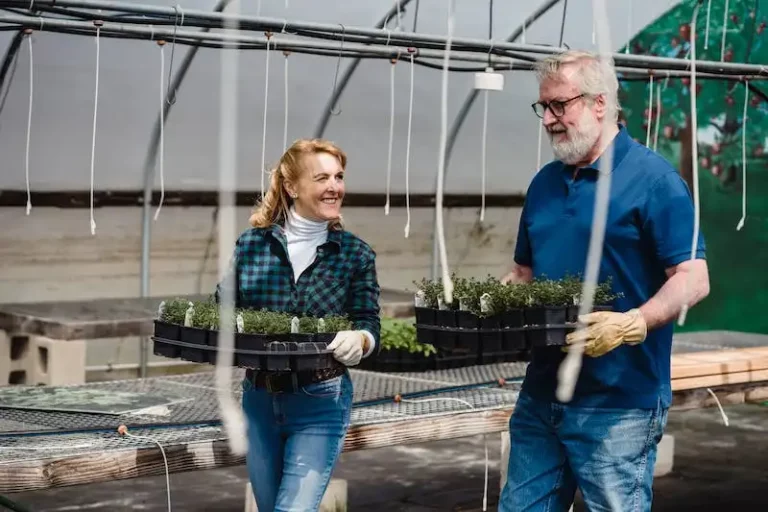The asparagus is a perennial vegetable that is commonly grown in many parts of the world. It requires a well-drained soil and plenty of sunlight. In order to grow healthy and abundant crops, proper care and management should be given to the asparagus field.
One of the important aspects in growing asparagus is irrigation. Asparagus plants are very sensitive to drought, so a regular and adequate supply of water is crucial for their growth. The irrigation should be done in a way that the water penetrates deeply into the soil, ensuring that the roots receive proper moisture.
When planting asparagus, it is important to select the right variety. There are varieties that are more adapted to specific conditions, such as soils and climates. It is also important to select healthy and vigorous crowns or seeds for planting. The crowns should be planted in well-prepared beds, with the roots spread out and the crown slightly bent onto the soil surface, making sure that the buds are facing upwards.
Asparagus is commonly planted in early spring, usually in March. The soil should be well-drained and the pH level should be between 6.0 and 7.0. The asparagus plants should be spaced at least 12 inches apart in rows, with the rows 4 to 5 feet apart. It is important to keep the planting area free from weeds and to provide adequate sunlight for the plants to grow.
During the growing season, asparagus plants should be cared for by providing sufficient water, nutrients, and sunlight. They should be fertilized with a balanced fertilizer, high in phosphates, once every two to three weeks. The plants should be carefully monitored for pests and diseases, and appropriate treatments should be applied if necessary.
Cooperative Extension Agriculture
The Cooperative Extension Agriculture program is a special initiative offered by each state’s university. It is designed to provide valuable information and resources to farmers, growers, and gardeners. One area of focus within the program is asparagus cultivation, a crop with unique characteristics and requirements.
Asparagus fields are typically located in airy and well-drained sites, beginning with the preparation of the planting site. The crown of the asparagus plant is at the heart of its growth, so it is important to ensure that it is properly placed and allowed to establish. This involves digging trenches and aligning the crowns along the bottom, ensuring that each year-old crown is spaced within the trench. Early planting allows the plants to over-winter and develop a strong root system, setting the stage for a great harvest.
Just like any other crop, asparagus fields can face problems such as pests and diseases. However, asparagus has some beneficial characteristics that help to combat these issues. For example, the depth of asparagus roots allows the plants to compete with weeds and reduces the need for cultivation. Additionally, the asparagus fern over-wintering in the field can act as a cover to prevent soil erosion and trap nutrients that would otherwise be lost.
One common problem faced by asparagus growers is the presence of cutworms. These pests can cause damage to the stalks of the asparagus plants as they emerge in the spring. To address this issue, it is important to review the results of studies done by the Cooperative Extension Agriculture program. These studies include recommendations on how to control cutworms and other pests, such as using beneficial insects or applying organic pesticides.
When it comes to asparagus yields, the combination of suitable soils, depth, and proper cultivation techniques can lead to excellent results. It is important for growers to choose the right hybrid varieties that are adapted to their specific conditions. This information and more can be found on the Cooperative Extension Agriculture program’s website.
Overall, asparagus cultivation can be a rewarding experience for any gardener or small-scale farmer. By following the guidelines provided by the Cooperative Extension Agriculture program, growers can maximize their yields and address any problems that may arise, ensuring a successful crop year after year.
Using Chickens and Cover Crops to Control Weeds in Asparagus
Controlling weeds is essential for a successful asparagus crop. One effective method of weed control is using chickens and cover crops in combination. This approach provides a natural and sustainable way to manage weeds while improving soil health.
Chickens are great weed managers as they love to forage and eat insects, weed seeds, and even small weed plants. By allowing chickens to roam in the asparagus field, they can help keep weeds under control throughout the growing season. They also provide natural fertilizer, enriching the soil.
Cover crops are another valuable tool for weed management. They work by outcompeting weeds for water, nutrients, and sunlight. In addition, cover crops help build organic matter and improve soil structure. When combined with chickens, cover crops create a cooperative weed control system.
One popular cover crop choice for asparagus is vetch. Vetch is a legume that fixes nitrogen into the soil, providing a natural source of fertility. Its vigorous growth shades out weeds and prevents their establishment. Other cover crops such as clover and winter rye can also be used, depending on the specific needs and situations of the asparagus field.
Asparagus is usually grown in rows, and cover crops are planted between these rows. The cover crops should be established before the asparagus spears appear in spring. They are then allowed to grow throughout the growing season until mid-summer, when the asparagus ferns start to spruce up. At this point, the cover crops are mowed and left as a natural mulch to suppress weed growth.
For best results, it is recommended to follow certain guidelines when using chickens and cover crops for weed control in asparagus:
|
– Use chickens that are well-adapted to your climate and can tolerate the asparagus field conditions. Some breeds, such as Rhode Island Reds or Buff Orpingtons, are known to be good foragers and weed eaters. – Introduce chickens to the asparagus field early in the season, allowing them time to establish their presence and forage for insects and weed seeds. – Provide chickens with adequate water, shade, and shelter. – Rotate chickens between different sections of the asparagus field to evenly distribute their foraging impact and avoid over-grazing in one area. – Choose cover crop varieties that are non-hybrid and compatible with the asparagus growing season. This ensures that they will be in sync with the life cycle of the asparagus and will not compete for resources. – Mow cover crops before they seed to prevent them from becoming weeds themselves. – Regularly monitor the asparagus field for any signs of pests or diseases and take appropriate actions to manage them. – Follow the recommendations of your local agricultural cooperative extension or department of agriculture for specific guidelines and best practices in your area. |
Using chickens and cover crops in combination is a sustainable and environmentally-friendly approach to weed control in asparagus. It helps maintain healthy soils, reduces the amount of manual weeding required, and promotes the overall health and productivity of the asparagus crop. By following the recommended guidelines, growers can effectively manage weeds while enjoying bountiful harvests.
The Farm
The management of the farm is in the hands of Gerald, a seasoned farmer with years of experience. He recommends starting with selecting the right kind of asparagus seeds to be grown in the fields. The farm has been established by the SARE program, and they provide guidelines for asparagus growers. Gerald and his family have mostly grown asparagus in their backyard, but this is their first time managing a larger farm.
The process begins in January, when the asparagus crowns are planted in the fields. The growers make sure to plant them at the right depth to manage the growth. The crown needs to be about 6-8 inches below the ground to ensure a healthy harvest. Gerald uses equipment to dig holes and transplant the crowns. The fields are then covered with a light layer of soil.
Once the planting is complete, the asparagus needs regular watering, especially during the warm season. The farm is mostly sunny, and the asparagus plants benefit from the abundant sunlight. However, they also have to deal with beetles and cutworms that can cause damage to the fronds and stems. Gerald uses original methods to control these pests, including manually removing the beetles or using beneficial insects to eat them. He also monitors for any signs of diseases or fungi.
Throughout the growing season, the asparagus plants should be monitored for weeds. Gerald and his family make sure to keep the fields as weed-free as possible, using hand-pulling and mechanical means to remove them. They also manage the humidity in the field, as high humidity can lead to disease problems. Proper airflow and spacing between the plants help prevent this.
Harvesting begins in late spring when the spears reach a suitable size. The plants are cut just above the ground, leaving some of the fronds intact to continue photosynthesis and provide energy for the next season. The farm usually sees good yields, which are sold to local markets and restaurants. Gerald hopes to expand his asparagus production in the future and continue to improve his farming practices.
In summary, managing an asparagus farm involves selecting the right seeds, proper planting and transplanting techniques, regular watering, pest and disease control, weed management, and harvesting methods. Gerald’s experience and knowledge have contributed to the success of the farm, and he continues to learn and adapt as he faces new challenges throughout the season.




